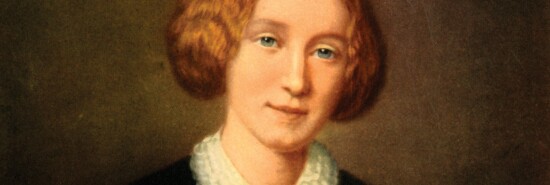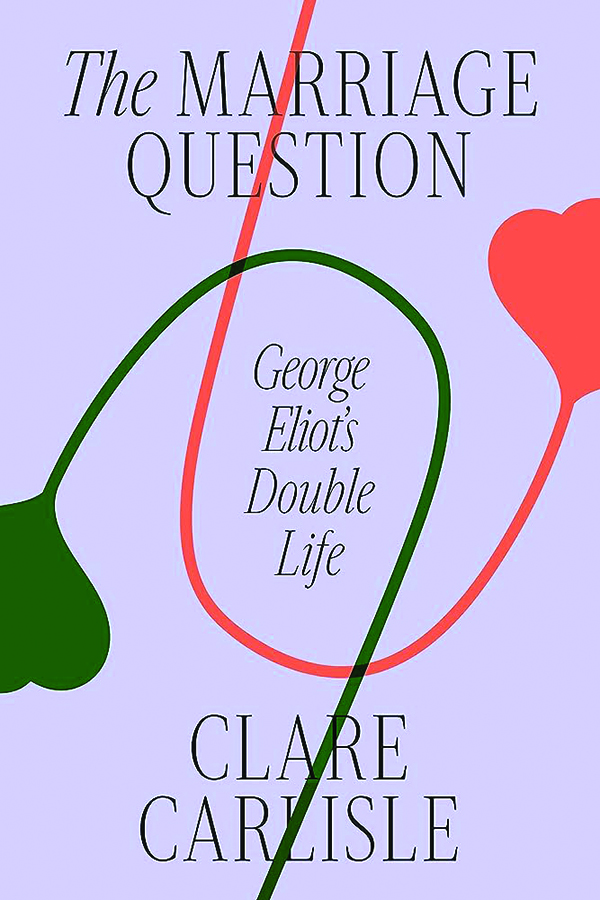
Review: The Marriage Question: George Eliot’s Double Life by Clare Carlisle
Malcolm Forbes
“Marriage must be a relation either of sympathy or of conquest,” George Eliot writes in Romola, a novel that presents marriage as the latter and charts the eponymous heroine’s efforts to escape a domineering husband. “Marriage is a state of higher duties,” the young Dorothea Brooke says in Middlemarch. “I never thought of it as mere personal ease.” Her marriage to the musty, dusty, cold-hearted scholar Casaubon, “a dried bookworm towards fifty,” turns out to be a trial. If only she had listened to her uncle, who declares marriage to be a “noose.” Gwendolen Harleth, in Eliot’s last novel, Daniel Deronda, feels a similar constriction in her marriage, imagining not a noose around her neck but rather the “throttling fingers” of her tyrannical husband Henleigh Grandcourt. In Eliot’s 1859 novella The Lifted Veil, love curdles into loathing for Latimer and Bertha, and their marriage becomes such an ordeal that she ends up conspiring with her maid to poison him.

In 1855, Eliot wrote to a friend: “If there be any one subject on which I feel no levity it is that of marriage and the relation of the sexes.” Clearly. For her, marriage mattered gravely. Her depictions of her characters’ marriages are suffused not with solemnity, for those marriages are serious affairs — mainly because they are difficult or disastrous. Mismatched couples flounder in chaotic alliances or toxic unions, husbands lose control and wives duck for cover, and wedded bliss proves woefully short-lived or tragically unattainable.
REVIEW: TOM LAKE BY ANN PATCHETT
Clare Carlisle’s new book about Eliot’s life and work, The Marriage Question, shows how the author skillfully illuminated the ups and downs of marriage in her fiction and how she evolved and thrived within her own unconventional relationship. A professor of philosophy at King’s College London, Carlisle also brings her field of study into the picture. At the start of The Marriage Question, she argues that throughout Eliot’s writing career, she grappled with “themes that belong to a philosophy of marriage,” such as desire, dependence, trust, disillusion, and morality. Carlisle explores those themes while tracking Eliot through the years, and the singular woman who emerges is not just a great writer but also a great mind.
Carlisle begins with her subject, 34-year-old Marian Evans, “leaping into a new life.” It is July 1854, and she has yet to adopt her nom de plume. Instead. Miss Evans is about to become Mrs. Lewes — albeit unofficially. She and the man she fell for one year earlier, the writer George Lewes, board a steamer in London and “elope” to the continent. However, they are not running away to tie the knot, for Lewes is already “irretrievably married”: He has a wife, an unfaithful one, and three children. He can’t afford a divorce, but he is prepared to risk public disgrace by living in sin with a new woman.
The stakes were higher for Eliot: “Whatever the state of his marriage, she would be seen to be committing adultery if she lived openly with him,” Carlisle explains. On their honeymoon of sorts in Germany, the pair enjoyed privacy away from prying eyes and knuckled down to individual writing projects — his a biography of Goethe, hers the first English translation of Spinoza’s Ethics. When they returned to London to face the music, Eliot found herself ostracized: Friends stopped including her at dinners and parties, and her brother and sister refused to communicate with her.
Hurt and angered by such rejection, Eliot dusted herself down and turned her attention to writing fiction. When the stories that make up Scenes of Clerical Life were published, George Eliot was born. The acceptance of those stories, and the acclaim they garnered, was, Carlisle notes, “a significant gesture towards the virtually unvisited, uninvited, unacceptable Mrs. Lewes.”
Success with short-form fiction led her to try her hand at writing longer work. Her first novel, Adam Bede, was published in 1859. It received rave reviews, and its author was hailed as a “man of genius.” Eventually, that author removed “the iron mask of my incognito” and disclosed her true identity. Fears that readers would be appalled to learn that George Eliot was really the scandalous, adulterous Mrs. Lewes were misplaced. In fact, widespread appreciation of her books resulted in more people coming to terms with her illicit coupledom with Lewes.
As Eliot’s renown grew, she and Lewes were able to open their doors to fellow eminent Victorians, from poets and painters to reformers and aristocrats. Richard Wagner, Ivan Turgenev, Henry Wadsworth Longfellow, and other luminaries journeyed from abroad to visit Eliot — many of them being, according to Carlisle, “struck first by what Henry James called ‘her vast ugliness.’” Some of her guests and correspondents became ardent admirers who bombarded her with letters and gifts.
It wasn’t only Eliot’s fame that increased over the years, but also her wealth. In 1862, she was offered the equivalent of 1 million pounds for Romola, on the strength of just a few chapters. Lewes, who earned far less than his wife, was ecstatic, correctly proclaiming it “the most magnificent offer ever yet made for a novel.” He would have been equally happy that Eliot deposited those earnings, like all those before and after it, into his bank account. Eliot’s husband did more than just hold the purse strings in their relationship. He was also her agent, publicist, and secretary. He listened to and gave advice on her work in progress and cheered her up and spurred her on when she was plagued by bouts of doubt and despair. Carlisle reveals that Eliot loved him despite his fits of temper and his bragging. Once, he boasted that “she does not write unless I make her do it.” On another occasion, he told a friend that his wife was no longer Marian Evans: “That individual is extinct, rolled up, mashed, absorbed in the Lewesian magnificence!”
Lewes died in 1878. Two years later, Eliot entered into a second, shorter, and this time legally recognized marriage with John Cross, a banker 20 years her junior. She had lived with Lewes for 24 years. Her marriage with Cross lasted a mere eight months. (It would have been even shorter if his suicide attempt on their Venetian honeymoon had been successful.) When Eliot died in 1880, she was buried next to Lewes, her life partner, soul mate, and intellectual equal.
Eliot was also buried with the letters she and Lewes wrote to one another. Carlisle imagines unearthing this lost correspondence and opening “the black box that recorded the inner workings of their shared life.” Such knowledge would clearly bring us closer to Eliot. But Carlisle’s book still paints a wonderfully intimate portrait. Eliot described her marriage as “this double life, which helps me to feel and think with double strength.” Carlisle’s captivating biography brilliantly examines that life and how those feelings and thoughts produced a run of remarkable novels that “still open our eyes and stretch our souls.”
CLICK HERE TO READ MORE FROM THE WASHINGTON EXAMINER
Malcolm Forbes has written for the Economist, the Wall Street Journal, and the Washington Post. He lives in Edinburgh.
